
Ai-Khanoum
Encyclopedia
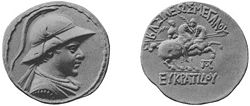
Uzbek language
Uzbek is a Turkic language and the official language of Uzbekistan. It has about 25.5 million native speakers, and it is spoken by the Uzbeks in Uzbekistan and elsewhere in Central Asia...
, possibly the historical Alexandria on the Oxus, also possibly later named اروکرتیه or Eucratidia
Eucratideia
Eucratideia was an ancient town in Bactria mentioned by a few ancient writers.It was most likely a foundation of Eucratides I who is the more important ruler of the Greco-Bactrian Kingdom with the name Eucratides. Not much is known about this city and it might be just a renaming of an already...
), was founded in the 4th century BC, following the conquests of Alexander the Great and was one of the primary cities of the Greco-Bactrian kingdom
Greco-Bactrian Kingdom
The Greco-Bactrian Kingdom was the easternmost part of the Hellenistic world, covering Bactria and Sogdiana in Central Asia from 250 to 125 BC...
. The city is located in Kunduz Province northern Afghanistan, at the confluence of the Oxus river (today's Amu Darya
Amu Darya
The Amu Darya , also called Oxus and Amu River, is a major river in Central Asia. It is formed by the junction of the Vakhsh and Panj rivers...
) and the Kokcha river, and at the doorstep of the Indian subcontinent
Indian subcontinent
The Indian subcontinent, also Indian Subcontinent, Indo-Pak Subcontinent or South Asian Subcontinent is a region of the Asian continent on the Indian tectonic plate from the Hindu Kush or Hindu Koh, Himalayas and including the Kuen Lun and Karakoram ranges, forming a land mass which extends...
. Ai Khanoum was one of the focal points of Hellenism in the East for nearly two centuries, until its annihilation by nomadic invaders around 145 BC about the time of the death of Eucratides.
The site was excavated through archaeological searches by a French DAFA mission under Paul Bernard
Paul Bernard
Paul Bernard was born in London, England on 20 June 1929, and died there on 25 September 1997.He is remembered as a television director, though he was also a designer on television, most notably on productions of The Avengers....
between 1964 and 1978, as well as Russian scientists. The searches had to be abandoned with the onset of the Soviet war in Afghanistan
Soviet war in Afghanistan
The Soviet war in Afghanistan was a nine-year conflict involving the Soviet Union, supporting the Marxist-Leninist government of the Democratic Republic of Afghanistan against the Afghan Mujahideen and foreign "Arab–Afghan" volunteers...
, during which the site was looted and used as a battleground, leaving very little of the original material.
Strategic location
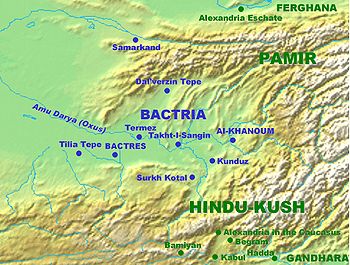
Hindu Kush
The Hindu Kush is an mountain range that stretches between central Afghanistan and northern Pakistan. The highest point in the Hindu Kush is Tirich Mir in the Chitral region of Khyber-Pakhtunkhwa, Pakistan.It is the westernmost extension of the Pamir Mountains, the Karakoram Range, and is a...
, especially the famous so-called "rubies" (actually, spinel
Spinel
Spinel is the magnesium aluminium member of the larger spinel group of minerals. It has the formula MgAl2O4. Balas ruby is an old name for a rose-tinted variety.-Spinel group:...
) from Badakshan, and gold
Gold
Gold is a chemical element with the symbol Au and an atomic number of 79. Gold is a dense, soft, shiny, malleable and ductile metal. Pure gold has a bright yellow color and luster traditionally considered attractive, which it maintains without oxidizing in air or water. Chemically, gold is a...
. Lastly, its location at the junction between Bactria
Bactria
Bactria and also appears in the Zend Avesta as Bukhdi. It is the ancient name of a historical region located between south of the Amu Darya and west of the Indus River...
n territory and nomad territories to the north, ultimately allowed access to commerce with the Chinese empire.
A Greek city in Bactria
Numerous artifacts and structures were found, pointing to a high Hellenistic culture, combined with Eastern influences. "It has all the hallmarks of a Hellenistic city, with a Greek theater, gymnasium and some Greek houses with colonnaded courtyards" (Boardman). Overall, Aï-Khanoum was an extremely important Greek city (1.5 sq kilometer), characteristic of the Seleucid EmpireSeleucid Empire
The Seleucid Empire was a Greek-Macedonian state that was created out of the eastern conquests of Alexander the Great. At the height of its power, it included central Anatolia, the Levant, Mesopotamia, Persia, today's Turkmenistan, Pamir and parts of Pakistan.The Seleucid Empire was a major centre...
and then the Greco-Bactrian Kingdom
Greco-Bactrian Kingdom
The Greco-Bactrian Kingdom was the easternmost part of the Hellenistic world, covering Bactria and Sogdiana in Central Asia from 250 to 125 BC...
.
It seems the city was destroyed, never to be rebuilt, about the time of the death of the Greco-Bactrian king Eucratides around 145 BC.
Ai-Khanoum may have been the city in which Eucratides was besieged by Demetrius, before he successfully managed to escape to ultimately conquer India (Justin
Junianus Justinus
Justin was a Latin historian who lived under the Roman Empire. His name is mentioned only in the title of his own history, and there it is in the genitive, which would be M. Juniani Justini no matter which nomen he bore.Of his personal history nothing is known...
).
Architecture
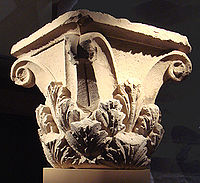
- Two-miles long ramparts, circling the city.
- A citadel with powerful towers (20x11 meters at the base, 10 meters in height) and ramparts, established on top of the 60 meters-high hill in the middle of the city.
- A Classical theater, 84 meters in diameter with 35 rows of seats, that could sit 4,000-6,000 people, equipped with three loges for the rulers of the city. Its size was considerable by Classical standards, larger than the theater at BabylonBabylonBabylon was an Akkadian city-state of ancient Mesopotamia, the remains of which are found in present-day Al Hillah, Babil Province, Iraq, about 85 kilometers south of Baghdad...
, but slightly smaller than the theater at EpidaurusEpidaurusEpidaurus was a small city in ancient Greece, at the Saronic Gulf. Two modern towns bear the name Epidavros : Palaia Epidavros and Nea Epidavros. Since 2010 they belong to the new municipality of Epidavros, part of the peripheral unit of Argolis...
. - A huge palace in Greco-Bactrian architecture, somehow reminiscent of formal Persian palatial architecture.
- A gymnasiumGymnasium (ancient Greece)The gymnasium in ancient Greece functioned as a training facility for competitors in public games. It was also a place for socializing and engaging in intellectual pursuits. The name comes from the Ancient Greek term gymnós meaning "naked". Athletes competed in the nude, a practice said to...
(100x100m), one of the largest of Antiquity. A dedication in Greek to HermesHermesHermes is the great messenger of the gods in Greek mythology and a guide to the Underworld. Hermes was born on Mount Kyllini in Arcadia. An Olympian god, he is also the patron of boundaries and of the travelers who cross them, of shepherds and cowherds, of the cunning of thieves, of orators and...
and Herakles was found engraved on one of the pillars. The dedication was made by two men with Greek names (Triballos and Strato, son of Strato). - Various temples, in and outside the city. The largest temple in the city apparently contained a monumental statue of a seated ZeusZeusIn the ancient Greek religion, Zeus was the "Father of Gods and men" who ruled the Olympians of Mount Olympus as a father ruled the family. He was the god of sky and thunder in Greek mythology. His Roman counterpart is Jupiter and his Etruscan counterpart is Tinia.Zeus was the child of Cronus...
, but was built of the Zoroastrian model (massive, closed walls instead of the open column-circled structure of Greek temples). - A mosaic representing the Macedonian sun, acanthusAcanthus (ornament)The acanthus is one of the most common plant forms to make foliage ornament and decoration.-Architecture:In architecture, an ornament is carved into stone or wood to resemble leaves from the Mediterranean species of the Acanthus genus of plants, which have deeply cut leaves with some similarity to...
leaves and various animals (crabs, dolphins etc...) - Numerous remains of Classical CorinthianCorinthian orderThe Corinthian order is one of the three principal classical orders of ancient Greek and Roman architecture. The other two are the Doric and Ionic. When classical architecture was revived during the Renaissance, two more orders were added to the canon, the Tuscan order and the Composite order...
columns.
Sculptural remains

Of special notice, a huge foot fragment in excellent Hellenistic style was recovered, which is estimated to have belonged to a 5-6 meter tall statue (which had to be seated to fit within the height of the columns supporting the Temple). Since the sandal of the foot fragment bears the symbolic depiction of Zeus
Zeus
In the ancient Greek religion, Zeus was the "Father of Gods and men" who ruled the Olympians of Mount Olympus as a father ruled the family. He was the god of sky and thunder in Greek mythology. His Roman counterpart is Jupiter and his Etruscan counterpart is Tinia.Zeus was the child of Cronus...
' thunderbolt
Thunderbolt
A thunderbolt is a discharge of lightning accompanied by a loud thunderclap or its symbolic representation. In its original usage the word may also have been a description of meteors, or, as Plato suggested in Timaeus, of the consequences of a close approach between two planetary cosmic bodies,...
, the statue is thought to have been a smaller version of the Statue of Zeus at Olympia
Statue of Zeus at Olympia
The Statue of Zeus at Olympia was made by the Greek sculptor Phidias, circa 432 BC on the site where it was erected in the Temple of Zeus, Olympia, Greece. It was one of the Seven Wonders of the Ancient World.-Description:...
.
Also found among the sculptural remains were:
- A statue of a standing female in a rather archaic chitonChiton (costume)A chiton was a form of clothing worn by men and women in Ancient Greece, from the Archaic period to the Hellenistic period ....
. - The face of a man, sculpted in stuccoStuccoStucco or render is a material made of an aggregate, a binder, and water. Stucco is applied wet and hardens to a very dense solid. It is used as decorative coating for walls and ceilings and as a sculptural and artistic material in architecture...
. - An unfinished statue of a young naked man with wreath.
- A gargoyleGargoyleIn architecture, a gargoyle is a carved stone grotesque, usually made of granite, with a spout designed to convey water from a roof and away from the side of a building thereby preventing rainwater from running down masonry walls and eroding the mortar between...
head representing the Greek cook-slave. - A frieze of a naked man, possibly the god HermesHermesHermes is the great messenger of the gods in Greek mythology and a guide to the Underworld. Hermes was born on Mount Kyllini in Arcadia. An Olympian god, he is also the patron of boundaries and of the travelers who cross them, of shepherds and cowherds, of the cunning of thieves, of orators and...
, wearing a chlamys. - A hermaHermaA Herma, commonly in English herm is a sculpture with a head, and perhaps a torso, above a plain, usually squared lower section, on which male genitals may also be carved at the appropriate height...
ic sculpture of an old man thought to be a master of the gymnasiumGymnasium (ancient Greece)The gymnasium in ancient Greece functioned as a training facility for competitors in public games. It was also a place for socializing and engaging in intellectual pursuits. The name comes from the Ancient Greek term gymnós meaning "naked". Athletes competed in the nude, a practice said to...
, where it was found. He used to hold a long stick in his left hand, symbol of his function.
Due to the lack of proper stones for sculptural work in the area of Ai-Khanoum, unbaked clay
Clay
Clay is a general term including many combinations of one or more clay minerals with traces of metal oxides and organic matter. Geologic clay deposits are mostly composed of phyllosilicate minerals containing variable amounts of water trapped in the mineral structure.- Formation :Clay minerals...
and stucco
Stucco
Stucco or render is a material made of an aggregate, a binder, and water. Stucco is applied wet and hardens to a very dense solid. It is used as decorative coating for walls and ceilings and as a sculptural and artistic material in architecture...
modeled on a wooden frame were often used, a technique which would become widespread in Central Asia and the East, especially in Buddhist art
Buddhist art
Buddhist art originated on the Indian subcontinent following the historical life of Siddhartha Gautama, 6th to 5th century BC, and thereafter evolved by contact with other cultures as it spread throughout Asia and the world....
. In some cases, only the hands and feet would be made in marble.
Epigraphic remains
Various inscriptions in Classical, non-barbarized, Greek have been found in Ai-Khanoum.- On a Herôon (funerary monument), identified in Greek as the tomb of Kineas (also described as the oikistesOikistesWhen a Greek polis chose to settle a new colony , an individual - the oikistes - was chosen as leader and invested with the power of selecting a settling place, directing the initial labors of the colonists and guiding the fledgling colony through its hard early years....
(founder) of the Greek settlement) and dated to 300-250 BC, an inscription has been found describing Delphic precepts:

- "Païs ôn kosmios ginou (As children, learn good manners)
- hèbôn enkratès, (as young men, learn to control the passions)
- mesos dikaios (in middle age, be just)
- presbutès euboulos (in old age, give good advice)
- teleutôn alupos. (then die, without regret.)"
The precepts were placed by a Greek named Clearchos, possibly Clearchus of Soli
Clearchus of Soli
Clearchus of Soli was a Greek philosopher of the 4th-3rd century BCE, belonging to Aristotle's Peripatetic school. He was born in Soli in Cyprus....
the disciple of Aristotle
Aristotle
Aristotle was a Greek philosopher and polymath, a student of Plato and teacher of Alexander the Great. His writings cover many subjects, including physics, metaphysics, poetry, theater, music, logic, rhetoric, linguistics, politics, government, ethics, biology, and zoology...
, who had copied them from Delphi
Delphi
Delphi is both an archaeological site and a modern town in Greece on the south-western spur of Mount Parnassus in the valley of Phocis.In Greek mythology, Delphi was the site of the Delphic oracle, the most important oracle in the classical Greek world, and a major site for the worship of the god...
:
- "Whence Klearchos, having copied them carefully, set them up, shining from afar, in the sanctuary of Kineas"

- Remains of some papyrusPapyrusPapyrus is a thick paper-like material produced from the pith of the papyrus plant, Cyperus papyrus, a wetland sedge that was once abundant in the Nile Delta of Egypt....
manuscripts, the imprint of which were left in the thin earth of brick walls, containing unknown philosophical dialogues on the theory of ideas, thought to be the only surviving remain of an AristotelianAristotleAristotle was a Greek philosopher and polymath, a student of Plato and teacher of Alexander the Great. His writings cover many subjects, including physics, metaphysics, poetry, theater, music, logic, rhetoric, linguistics, politics, government, ethics, biology, and zoology...
dialogue, possibly the Sophist, where XenocratesXenocratesXenocrates of Chalcedon was a Greek philosopher, mathematician, and leader of the Platonic Academy from 339/8 to 314/3 BC. His teachings followed those of Plato, which he attempted to define more closely, often with mathematical elements...
, another philosopher, present his theory of ideas.
- Various Greek inscriptions were also found in the Treasury of the palace, indicating the contents (money, imported olive oil...) of various vases, and names of the administrators in charge of them. The hierarchy of these administrators appears to be nearly identical to that in the Mediterranean Greek areas. From the names mentioned in these inscriptions, it appears that the directors of the Treasury were Greek, but that lower administrators had Bactrian names. Three signatories had Greek names (Kosmos, Isidora, Nikeratos), one a Macedonian or Thracian name (Lysanias), and two Bactrian names (Oxuboakes, Oxubazes).
One of these economic inscriptions relates in Greek the deposit of olive oil jars in the treasury:
- "In the year 24, on ....;
- an olive oil (content);
- the partially empty (vase) A (contains) oil transferred from
- two jars by Hippias
- the hemiolios; and did seal:
- Molossos (?) for jar A, and Strato (?) for jar B (?)"
The last of the dates on these jars has been computed to 147 BC, suggesting that Ai-Khanoum was destroyed soon after that date.
Artifacts
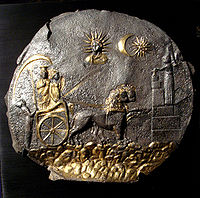
Agathocles of Bactria
Agathocles Dikaios was a Buddhist Indo-Greek king, who reigned between around 190 and 180 BCE. He might have been a son of Demetrius and one of his sub-kings in charge of the Paropamisade between Bactria and India...
, consisting of six Indian-standard silver drachms depicting Hindu deities. These are the first known representations of Vedic deities
Rigvedic deities
There are 1028 hymns in the Rigveda, most of them dedicated to specific deities.Indra, a heroic god, slayer of Vrtra and destroyer of the Vala, liberator of the cows and the rivers; Agni the sacrificial fire and messenger of the gods; and Soma the ritual drink dedicated to Indra are the most...
on coins, and they display early Avatar
Avatar
In Hinduism, an avatar is a deliberate descent of a deity to earth, or a descent of the Supreme Being and is mostly translated into English as "incarnation," but more accurately as "appearance" or "manifestation"....
s of Vishnu
Vishnu
Vishnu is the Supreme god in the Vaishnavite tradition of Hinduism. Smarta followers of Adi Shankara, among others, venerate Vishnu as one of the five primary forms of God....
: Balarama
Balarama
Balarama , also known as Baladeva, Balabhadra and Halayudha, is the elder brother of the divine being, Krishna in Hinduism. Within Vaishnavism Hindu traditions Balarama is worshipped as an Avatar of Vishnu, and he is also listed as such in the Bhagavata Purana...
-Samkarshana and Vasudeva
Vasudeva
In Hindu itihasa , Vasudeva is the father of Krishna, the son of Shoorsen, of the Yadu and Vrishni dynasties. His sister Kunti was married to Pandu. He was a partial incarnation of Rishi Kashyap....
-Krishna
Krishna
Krishna is a central figure of Hinduism and is traditionally attributed the authorship of the Bhagavad Gita. He is the supreme Being and considered in some monotheistic traditions as an Avatar of Vishnu...
, and are thought to correspond to the first Greco-Bactrian attempts at creating an Indian-standard coinage as they invaded northern India.
Among other finds:
- A round medallion plate describing the goddess CybeleCybeleCybele , was a Phrygian form of the Earth Mother or Great Mother. As with Greek Gaia , her Minoan equivalent Rhea and some aspects of Demeter, Cybele embodies the fertile Earth...
on a chariot, in front of a fire altar, and under a depiction of HeliosHeliosHelios was the personification of the Sun in Greek mythology. Homer often calls him simply Titan or Hyperion, while Hesiod and the Homeric Hymn separate him as a son of the Titans Hyperion and Theia or Euryphaessa and brother of the goddesses Selene, the moon, and Eos, the dawn...
. - A fully preserved bronze statue of Herakles.
- Various golden serpentine arm jewellery and hearings.
- Some Indian artifacts, found in the treasure room of the city, probably brought back by Eucratides from his campaigns.
- A toilet tray representing a seated AphroditeAphroditeAphrodite is the Greek goddess of love, beauty, pleasure, and procreation.Her Roman equivalent is the goddess .Historically, her cult in Greece was imported from, or influenced by, the cult of Astarte in Phoenicia....
. - A mold representing a bearded and diademed middle-aged man.
Various artifacts of daily life are also clearly Hellenistic: sundial
Sundial
A sundial is a device that measures time by the position of the Sun. In common designs such as the horizontal sundial, the sun casts a shadow from its style onto a surface marked with lines indicating the hours of the day. The style is the time-telling edge of the gnomon, often a thin rod or a...
s, ink wells, tableware.
Trade with the Mediterranean
The presence of olive oilOlive oil
Olive oil is an oil obtained from the olive , a traditional tree crop of the Mediterranean Basin. It is commonly used in cooking, cosmetics, pharmaceuticals, and soaps and as a fuel for traditional oil lamps...
jars at Ai Khanoum indicates that this oil was imported from the Mediterranean, as its only possible source would have been the Aegean Basin
Aegean Sea
The Aegean Sea[p] is an elongated embayment of the Mediterranean Sea located between the southern Balkan and Anatolian peninsulas, i.e., between the mainlands of Greece and Turkey. In the north, it is connected to the Marmara Sea and Black Sea by the Dardanelles and Bosporus...
or Syria
Syria
Syria , officially the Syrian Arab Republic , is a country in Western Asia, bordering Lebanon and the Mediterranean Sea to the West, Turkey to the north, Iraq to the east, Jordan to the south, and Israel to the southwest....
. This suggests important trade contacts with the Mediterranean, through long and expensive land routes.
Contacts with India
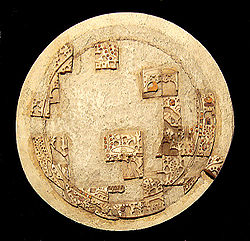
Afghanistan
Afghanistan , officially the Islamic Republic of Afghanistan, is a landlocked country located in the centre of Asia, forming South Asia, Central Asia and the Middle East. With a population of about 29 million, it has an area of , making it the 42nd most populous and 41st largest nation in the world...
up to the Hindu Kush
Hindu Kush
The Hindu Kush is an mountain range that stretches between central Afghanistan and northern Pakistan. The highest point in the Hindu Kush is Tirich Mir in the Chitral region of Khyber-Pakhtunkhwa, Pakistan.It is the westernmost extension of the Pamir Mountains, the Karakoram Range, and is a...
(Paropamisadae
Paropamisadae
Paropamisadae or Paropamisus was the ancient Greek name for a region of the Hindu-Kush in eastern Afghanistan, centered on the cities of Kabul and Kapisa .-History of Paropamisadae:...
) seems to have been occupied by the Mauryan Empire between 305 BC until the reconquest by Demetrius
Demetrius I of Bactria
Demetrius I was a Buddhist Greco-Bactrian king . He was the son of Euthydemus and succeeded him around 200 BC, after which he conquered extensive areas in what now is eastern Iran, Afghanistan and Pakistan thus creating an Indo-Greek kingdom far from Hellenistic Greece...
in 180 BC, Ai Khanum was in effect a frontier town, located just a few kilometers from Indian dominions, for more than a century.
Several Indian artifacts were found among the archaeological remains of Ai Khanoum, especially a narrative plate made of shell inlaid with various materials and colors, thought to represent the Indian myth of Kuntala
Kuntala
Kuntala is a village and a Mandal in Adilabad district in the state of Andhra Pradesh in India. Kuntala has the highest waterfalls in the Andhra Pradesh state with a height of 45 meters.-The waterfall:Main article: Kuntala Waterfall...
.
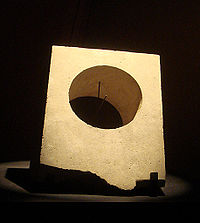
Rigvedic deities
There are 1028 hymns in the Rigveda, most of them dedicated to specific deities.Indra, a heroic god, slayer of Vrtra and destroyer of the Vala, liberator of the cows and the rivers; Agni the sacrificial fire and messenger of the gods; and Soma the ritual drink dedicated to Indra are the most...
: the early Avatar
Avatar
In Hinduism, an avatar is a deliberate descent of a deity to earth, or a descent of the Supreme Being and is mostly translated into English as "incarnation," but more accurately as "appearance" or "manifestation"....
s of Vishnu
Vishnu
Vishnu is the Supreme god in the Vaishnavite tradition of Hinduism. Smarta followers of Adi Shankara, among others, venerate Vishnu as one of the five primary forms of God....
, Balarama
Balarama
Balarama , also known as Baladeva, Balabhadra and Halayudha, is the elder brother of the divine being, Krishna in Hinduism. Within Vaishnavism Hindu traditions Balarama is worshipped as an Avatar of Vishnu, and he is also listed as such in the Bhagavata Purana...
-Sankarshana
Shesha
In Hindu tradition, Shesha or Sheshanaag is the king of all nagas, one of the primal beings of creation, and according to the Bhagavata Purana, an Avatar of the Supreme God known as Sankarshan. In the Puranas, Shesha is said to hold all the planets of the Universe on his hoods and to constantly...
and Vasudeva
Vasudeva
In Hindu itihasa , Vasudeva is the father of Krishna, the son of Shoorsen, of the Yadu and Vrishni dynasties. His sister Kunti was married to Pandu. He was a partial incarnation of Rishi Kashyap....
-Krishna
Krishna
Krishna is a central figure of Hinduism and is traditionally attributed the authorship of the Bhagavad Gita. He is the supreme Being and considered in some monotheistic traditions as an Avatar of Vishnu...
.
The various sun-dials, including a tropical sundial adjusted to the latitude of Ujjain
Ujjain
Ujjain , is an ancient city of Malwa region in central India, on the eastern bank of the Kshipra River , today part of the state of Madhya Pradesh. It is the administrative centre of Ujjain District and Ujjain Division.In ancient times the city was called Ujjayini...
found in the excavations also suggest that some transmission into Indian astronomy
Hindu astronomy
Historical Indian astronomy develops as a discipline of Vedanga or one of the "auxiliary disciplines" associated with the study of the Vedas.The oldest extant text of astronomy is the treatise by Lagadha, dated to the Mauryan era ....
may have happened, due to the numerous interactions with the Mauryan Empire, and the later expansion of the Indo-Greeks into India.
Numismatics

Bactria
Bactria and also appears in the Zend Avesta as Bukhdi. It is the ancient name of a historical region located between south of the Amu Darya and west of the Indus River...
n coins were found at Ai-Khanoum, as were ten blank planchets, indicating that there was a mint in the city. Ai Khanoum apparently had a city symbol (a triangle within a circle, with various variations), which was found imprinted on bricks coming from the oldest buildings of the city.
The same symbol was used on various Seleucid eastern coins, suggesting that they were probably minted in Ai Khanoum. Numerous Seleucid coins were thus reattributed to the Ai Khanoum mint rather recently, with the conclusion that Ai Khanoum was probably a larger minting center than even Bactra.
The coins found in Ai Khanoum start with those of Seleucus
Seleucus
-Monarchs and relations of the Seleucid Empire:* Seleucus I Nicator , son of Antiochus and founder of the Seleucid Empire* Seleucus II Callinicus * Seleucus III Ceraunus...
, but end abruptly with those of Eucratides, suggesting that the city was conquered at the end of his rule.
Nomadic invasions
The invading Indo-European nomads from the north (the ScythiansIndo-Scythians
Indo-Scythians is a term used to refer to Sakas , who migrated into Bactria, Sogdiana, Arachosia, Gandhara, Kashmir, Punjab, Haryana, Uttar Pradesh, Gujarat, Maharashtra and Rajasthan, from the middle of the 2nd century BCE to the 4th century CE....
and then the Yuezhi
Yuezhi
The Yuezhi, or Rouzhi , also known as the Da Yuezhi or Da Rouzhi , were an ancient Central Asian people....
) crossed the Oxus and submerged Bactria about 135 BC.
It seems the city was totally abandoned between 130-120 BC following the Yuezhi
Yuezhi
The Yuezhi, or Rouzhi , also known as the Da Yuezhi or Da Rouzhi , were an ancient Central Asian people....
invasion. There is evidence of huge fires in all the major buildings of the city.
The last Greco-Bactrian king Heliocles moved his capital from Balkh
Balkh
Balkh , was an ancient city and centre of Zoroastrianism in what is now northern Afghanistan. Today it is a small town in the province of Balkh, about 20 kilometers northwest of the provincial capital, Mazar-e Sharif, and some south of the Amu Darya. It was one of the major cities of Khorasan...
around 125 BC and resettled in the Kabul valley. No coins of Heliokles have been found in Ai-Khanoum, suggesting the city was destroyed at the end of the reign of Eucratides. The Greeks continued to rule various parts of northern India under the Indo-Greek Kingdom
Indo-Greek Kingdom
The Indo-Greek Kingdom or Graeco-Indian Kingdom covered various parts of the northwest regions of the Indian subcontinent during the last two centuries BC, and was ruled by more than 30 Hellenistic kings, often in conflict with each other...
until around 10 CE, when their last kingdom was conquered by the Indo-Scythians. Only a few decades later, the Yuezhi
Yuezhi
The Yuezhi, or Rouzhi , also known as the Da Yuezhi or Da Rouzhi , were an ancient Central Asian people....
united to form the Kushan Empire
Kushan Empire
The Kushan Empire originally formed in the early 1st century AD under Kujula Kadphises in the territories of ancient Bactria on either side of the middle course of the Oxus in what is now northern Afghanistan, Pakistan, and southern Tajikistan and Uzbekistan.During the 1st and early 2nd centuries...
and expanded in northern India themselves.
As with other archaeological sites such as Begram or Hadda
Hadda
Hadda is a Greco-Buddhist archeological site located in the ancient area of Gandhara, near the Khyber Pass, ten kilometers south of the city of Jalalabad in today's eastern Afghanistan.-Background:...
, the Ai-Khanoum site has been pillaged during the long phase of war in Afghanistan since the fall of the Communist government.
Significance

This discovery gives a new perspective on the influence of Greek culture in the East, and reaffirms the influence of the Greeks on the development of Greco-Buddhist art
Greco-Buddhist art
Greco-Buddhist art is the artistic manifestation of Greco-Buddhism, a cultural syncretism between the Classical Greek culture and Buddhism, which developed over a period of close to 1000 years in Central Asia, between the conquests of Alexander the Great in the 4th century BCE, and the Islamic...
.
An almost life-sized dark green glass phallus
Phallus
A phallus is an erect penis, a penis-shaped object such as a dildo, or a mimetic image of an erect penis. Any object that symbolically resembles a penis may also be referred to as a phallus; however, such objects are more often referred to as being phallic...
with a small owl on the back side and other treasures are said to have been discovered at Ai Khanoum, possibly along with a stone with an inscription, which was not recovered. The artifacts have now been returned to the Kabul Museum
Kabul Museum
The National Museum of Afghanistan , also known as the Afghan National Museum or the Kabul Museum, is a two-story building located 9 km southwest of the center of Kabul City in Afghanistan. It was built in 1922 during the reign of King Amanullah Khan...
after several years in Switzerland by Paul Bucherer-Dietschi, Director of the Swiss Afghanistan Institute.
See also
- Seleucid EmpireSeleucid EmpireThe Seleucid Empire was a Greek-Macedonian state that was created out of the eastern conquests of Alexander the Great. At the height of its power, it included central Anatolia, the Levant, Mesopotamia, Persia, today's Turkmenistan, Pamir and parts of Pakistan.The Seleucid Empire was a major centre...
- Greco-Bactrian KingdomGreco-Bactrian KingdomThe Greco-Bactrian Kingdom was the easternmost part of the Hellenistic world, covering Bactria and Sogdiana in Central Asia from 250 to 125 BC...
- Indo-Greek KingdomIndo-Greek KingdomThe Indo-Greek Kingdom or Graeco-Indian Kingdom covered various parts of the northwest regions of the Indian subcontinent during the last two centuries BC, and was ruled by more than 30 Hellenistic kings, often in conflict with each other...
- YuezhiYuezhiThe Yuezhi, or Rouzhi , also known as the Da Yuezhi or Da Rouzhi , were an ancient Central Asian people....
- Kushan EmpireKushan EmpireThe Kushan Empire originally formed in the early 1st century AD under Kujula Kadphises in the territories of ancient Bactria on either side of the middle course of the Oxus in what is now northern Afghanistan, Pakistan, and southern Tajikistan and Uzbekistan.During the 1st and early 2nd centuries...
- Indo-ScythiansIndo-ScythiansIndo-Scythians is a term used to refer to Sakas , who migrated into Bactria, Sogdiana, Arachosia, Gandhara, Kashmir, Punjab, Haryana, Uttar Pradesh, Gujarat, Maharashtra and Rajasthan, from the middle of the 2nd century BCE to the 4th century CE....
External links
- Ai Khatum, the Capital of Eucratides on Ancient History Encyclopedia
- Ai Khanoum archaeological site photographs
- Ai-Khanoum and vandalization during the Afghan war
- The Hellenistic Age
- Afghan Treasures
- 3-D reconstitution of Ai Khanoum
- Livius.org: Alexandria on Oxus
- Afghanistan: Crossroads of the Ancient World Surviving treasures from the National Museum of Afghanistan, at The British Museum, 3 March – 17 July 2011

